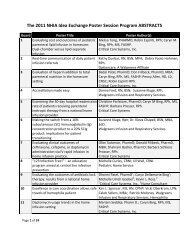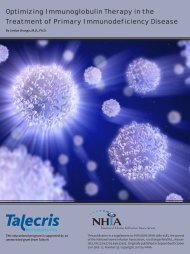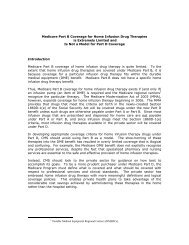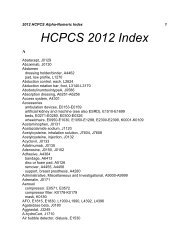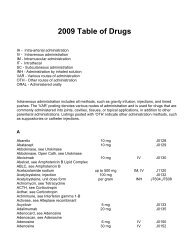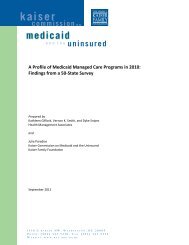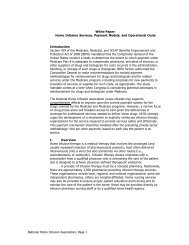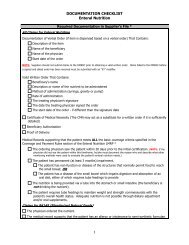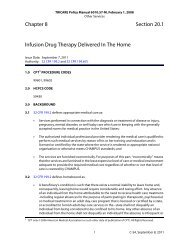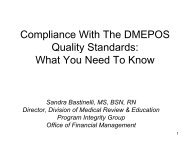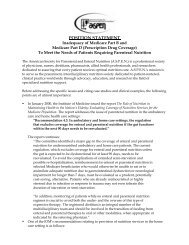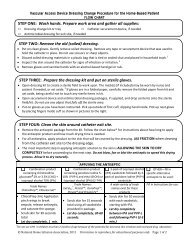Navigating Home Care: Parenteral Nutrition—Part Two
Navigating Home Care: Parenteral Nutrition—Part Two
Navigating Home Care: Parenteral Nutrition—Part Two
Create successful ePaper yourself
Turn your PDF publications into a flip-book with our unique Google optimized e-Paper software.
NUTRITION ISSUES IN GASTROENTEROLOGY, SERIES #11<br />
Series Editor: Carol Rees Parrish, M.S., R.D., CNSD<br />
<strong>Navigating</strong> <strong>Home</strong> <strong>Care</strong>:<br />
<strong>Parenteral</strong> <strong>Nutrition—Part</strong> <strong>Two</strong><br />
by Gisela Barnadas<br />
<strong>Parenteral</strong> nutrition (PN) is often used for patients who are unable to absorb sufficient<br />
nutrition through the gastrointestinal tract. PN can be safely administered in the<br />
home setting with proper assessment and monitoring of the patient. An interdisciplinary<br />
team approach is used to identify and avoid potential complications, which may<br />
occur. This article provides the physician with specific guidelines for evaluating,<br />
ordering and monitoring PN therapy in the home patient. It also addresses financial<br />
and reimbursement considerations with emphasis on understanding the often confusing,<br />
Medicare guidelines.<br />
CASE 1<br />
JR is a 65-year-old female with vascular disease,<br />
hypertension, diabetes and history of a hysterectomy.<br />
She presents with severe abdominal pain, vomiting and<br />
diarrhea. A small bowel series documents a bowel<br />
obstruction, most likely due to bowel ischemia. Findings<br />
during surgical intervention included: twisted,<br />
gangrenous small bowel with multiple adhesions<br />
resulting in resection of her distal jejunum, ileum and<br />
right colon, leaving an intact duodenum, approximately<br />
100 cm of the jejunum and most of her left colon. She<br />
will most likely require TPN for the rest of her life.<br />
• What needs to be considered to successfully manage<br />
her nutritional needs at home<br />
• How many calories How many grams of protein<br />
• How much volume will she need<br />
• Should I use a standard solution, or does this patient<br />
require something special<br />
• Can the patient and /or caregiver and/or family<br />
manage this therapy at home<br />
Gisela Barnadas, RD, MS, <strong>Home</strong> Nutrition Support<br />
Specialist, MedStar Health Infusion, Inc., Greater<br />
Washington, DC/Baltimore Area.<br />
• What resources are available to help manage this<br />
patient in the home<br />
• What resources are there available for the patient<br />
• Will insurance pay for this<br />
Providing total parenteral nutrition in the home<br />
(HPN) is by no means a new treatment option. The<br />
first record of a patient receiving HPN was a 36-yearold<br />
woman with extensive metastatic ovarian carcinoma<br />
in 1968.(1) While the exact number of people<br />
receiving HPN is not known, Dr Lyn Howard in the<br />
late 1980s and early 1990s in an attempt to establish a<br />
database, estimated approximately 45,000 were on<br />
HPN (2).<br />
Much has changed since the first patient received<br />
HPN thirty-five years ago. With the advent of newer<br />
technologies and greater clinical expertise, HPN can<br />
be safely administered in the home for many conditions.<br />
However, along with improvements in this therapy,<br />
a myriad of challenges to the managing physician<br />
and health care team have also arisen.<br />
The majority of patients end up on HPN after a<br />
hospital admission, others may be a “new start up” at<br />
home (to be addressed later in this article). Regardless,<br />
successful HPN requires evaluating the patient for<br />
PRACTICAL GASTROENTEROLOGY • NOVEMBER 2003 13
<strong>Navigating</strong> <strong>Home</strong> <strong>Care</strong>: <strong>Parenteral</strong> <strong>Nutrition—Part</strong> <strong>Two</strong><br />
NUTRITION ISSUES IN GASTROENTEROLOGY, SERIES #11<br />
Table 1<br />
HPN Checklist: Is Patient A Suitable Candidate<br />
• Risks and benefits of therapy have been discussed with<br />
patient.<br />
• All attempts to use GI tract have failed unless patient is<br />
clearly not appropriate for enteral feedings.<br />
• Modification of diet, use of feeding tube, special formulas,<br />
digestive enzymes, antiemetics, etc. have been<br />
attempted or considered.<br />
• Use of therapy is consistent with level of medical care.<br />
• Patient and/or caregiver assumes role of primary caregiver<br />
and is willing to administer therapy.<br />
• Patient and/or caregivers are capable to perform the<br />
task. Must demonstrate sound judgment and motivation<br />
to learn.<br />
• Patient and/or caregivers accept emotional requirements<br />
to administer therapy at home.<br />
• Patient and /or caregiver meet physical requirement to<br />
provide care (manual dexterity, adequate vision, physical<br />
strength to carry >10 lbs).<br />
• Patient is medically stable (requires labs no more than<br />
1–2× per week, glucose is controlled while on TPN).<br />
• <strong>Home</strong> environment is reasonably clean and has physical<br />
requirements needed to provide therapy (electricity,<br />
water, refrigeration, telephone).<br />
• Financial considerations/insurance coverage and patient<br />
responsibilities have been explored and patient and<br />
caregivers understand (and accept) cost.<br />
Used with permission Barnadas, G: Nutrition in <strong>Home</strong>care: PN<br />
module (4)<br />
HPN, coordinating their care with close follow-up and<br />
monitoring of clinical progress.<br />
Preparing the Patient for Discharge<br />
Is the patient appropriate for home therapy<br />
Identifying appropriate patients for home therapy is<br />
the first step toward successful HPN (3). Planning<br />
should begin early in order to identify potential obstacles,<br />
which may arise. The medical condition should<br />
be relatively stable. Vital signs, glucose, fluid and electrolytes<br />
are normal (or normal for the patient). Treatment<br />
and therapy options have been discussed and<br />
understood. See Table 1 for a suggested checklist to<br />
determine if patient is appropriate for HPN.<br />
Who will administer the therapy<br />
While care of the patient on HPN will be coordinated<br />
among an interdisciplinary health care team, the<br />
patients and/or their designated caregiver will ultimately<br />
be responsible for administering the therapy.<br />
Skilled IV nurses will be utilized initially to administer<br />
the therapy while the patient and/or their caregivers<br />
are taught. Typically it takes two-to three-days before<br />
the patient is expected to reach a point of self-sufficiency<br />
in the administration of the therapy. (Note: the<br />
role of the home care nurse is to educate the patient<br />
and caregivers until they are independent to<br />
administer the therapy. A common misconception<br />
is that the nurse will be there to administer the<br />
therapy and stay with the patient during the entire<br />
Table 2<br />
Nutrition Support Resources Available<br />
• Oley Foundation www.oley.org 800-776-OLEY<br />
– Has a large patient network that allows patients and<br />
caregivers to communicate with others in similar<br />
situations<br />
– Provides website information<br />
– A free newsletter for patients<br />
– A toll free network<br />
– Equipment exchange<br />
– Strong parents support group<br />
– Annual national conference for patients,<br />
families/caregivers<br />
• American Society of <strong>Parenteral</strong> and Enteral Nutrition<br />
(ASPEN) www.nutritioncare.org (800) 727- 4567<br />
– Standards of Practice for <strong>Home</strong> Nutrition Support<br />
(5)<br />
• Canadian <strong>Parenteral</strong>-Enteral Nutrition Association<br />
(CPENA) www.cpena.ca/home.html 613-825-4341<br />
(Ottawa)<br />
(continued on page 16)<br />
14<br />
PRACTICAL GASTROENTEROLOGY • NOVEMBER 2003
<strong>Navigating</strong> <strong>Home</strong> <strong>Care</strong>: <strong>Parenteral</strong> <strong>Nutrition—Part</strong> <strong>Two</strong><br />
NUTRITION ISSUES IN GASTROENTEROLOGY, SERIES #11<br />
(continued from page 14)<br />
Table 3<br />
Medicare Guidelines for TPN<br />
Clinical Situation<br />
Examples of ICD codes<br />
A Severe short bowel syndrome 579.3 Other and unspecified postsurgical nonabsorption<br />
Surgery within past 3 months, leaving ≤5 feet<br />
of small bowel beyond the ligament of the Treitz<br />
B Severe short bowel syndrome 579.3 Other and unspecified postsurgical nonabsorption<br />
(>3 months ago) that results in: evidence of electrolyte<br />
malabsorption AND fluid intake of 2.5–3 L/day results<br />
in enteral losses that exceed 50% of the oral/enteral<br />
intake AND Urine output less that 1 L/day<br />
C Bowel rest for at least 3 months 555.0 Regional enteritis of small intestine<br />
Symptomatic pancreatitis with or without pancreatic 555.1 Regional enteritis of large intestine<br />
pseudocyst OR severe exacerbation of regional enteritis 555.2 Regional enteritis of small with large intestine<br />
OR proximal enterocutaneous fistula where tube feedings 577.0 Acute pancreatitis<br />
distal to the fistula is not possible.<br />
577.1 Chronic pancreatitis<br />
569.81 Fistula of small intestine<br />
998.6 Persistent postoperative fistula, complication of<br />
procedure<br />
D Complete mechanical small bowel obstruction where 560.81 Intestinal or peritoneal adhesions with obstructions<br />
surgery is not an option and where tube feelings distal 560.89 Specified intestinal obstruction, by mural<br />
to the obstruction is not possible<br />
thickening (i.e. Crohn’s)<br />
560.9 Unspecified intestinal obstruction<br />
557.1 Chronic vascular insufficiency of intestine (superior<br />
mesenteric artery (SMA) syndrome) probably goes<br />
with 560.9 unspecified intestinal obstruction<br />
E<br />
Malabsorption and malnutrition<br />
Severe fat malabsorption (fecal fat exceeds 50% or<br />
oral/enteral intake on a diet of at least 50 gm of fat per<br />
day as measured by a standard 72-hour fecal fat test).<br />
AND malnutrition, as evidenced by: 10% weight loss<br />
over 3 months or less AND serum albumin equal to<br />
or less that 3.4 gm/DL<br />
579.9 Unspecified intestinal malabsorption<br />
AND 263.9 Calorie malnutrition<br />
AND 273.8 Hypoalbuminemia<br />
F Motility disturbance and malnutrition 536.3 Gastroparesis<br />
Severe motility disorder of the small intestine and/or 564.9 Unspecified functional disorder of intestine<br />
stomach, which is unresponsive to prokinetic medications<br />
and is demonstrated scintigraphically or radiographically.<br />
AND malnutrition, as evidenced by: 10% weight loss AND 263.9 Calorie malnutrition<br />
over 3 months or less AND serum albumin equal to or AND 273.8 Hypoalbuminemia<br />
less that 3.4 gm/DL<br />
(continued on page 19)<br />
16<br />
PRACTICAL GASTROENTEROLOGY • NOVEMBER 2003
<strong>Navigating</strong> <strong>Home</strong> <strong>Care</strong>: <strong>Parenteral</strong> <strong>Nutrition—Part</strong> <strong>Two</strong><br />
NUTRITION ISSUES IN GASTROENTEROLOGY, SERIES #11<br />
(continued from page 16)<br />
Table 3 (continued)<br />
Medicare Guidelines for TPN<br />
Clinical Situation<br />
Examples of ICD codes<br />
G Malnourished as evidenced by: 10% weight loss over 263.9 Calorie malnutrition<br />
3 months or less<br />
+ AND serum albumin equal to or less that 3.4 gm/DL AND 273.8 Hypoalbuminemia<br />
H AND Has a disease and clinical condition documented AND Any non severe manifestation of above such as:<br />
as being present and it has not responded to altering<br />
• Mild to moderate exacerbation of Crohns<br />
the manner of delivery of appropriate nutrients<br />
• Distal entercutaneous fistula<br />
• Partial bowel obstruction<br />
• Mild to Moderate fat malabsorption<br />
• Mild to Moderate GI dysmotility<br />
Used with permission Barnadas, G: Nutrition in <strong>Home</strong>care: PN module (4)<br />
infusion.) For most patients on HPN, nursing visits<br />
after the first week of therapy are often reduced to<br />
once per week to supervise compliance, provide site<br />
dressing care and obtain lab work. While the patient<br />
may wish to assume all the responsibility for the therapy,<br />
physical and medical limitations sometimes<br />
require a dependable caregiver to assume this responsibility.<br />
A certain amount of visual acuity, physical<br />
strength and manual dexterity is needed to administer<br />
the solution, operate the pump and care for the<br />
catheter. <strong>Care</strong>givers are often very apprehensive when<br />
it comes to administering therapy. While they are anxious<br />
to get the patient back home, they also have fears<br />
they might harm their loved one in the process of providing<br />
care.<br />
Is there a safe home environment<br />
A proper home environment is essential to safely provide<br />
the therapy and avoid infection or other complications.<br />
The home should be stable, safe, relatively<br />
clean and meet certain physical requirements. HPN<br />
therapy requires refrigeration of the solution and maintenance<br />
of a sterile field during catheter care and formula<br />
administration. If the home does not have electricity,<br />
running water and a telephone, alternative plans<br />
may need to be explored. For example, limited telephone<br />
service for medical emergencies can be<br />
arranged through the local telephone company, or<br />
power can be restored under special funds available for<br />
patients receiving life-supporting therapies. Certain<br />
home environments are not safe or appropriate for the<br />
therapy and alternative plans must be investigated.<br />
Social And Emotional Considerations<br />
Food is a very important part of our social environment.<br />
It is a focal point at most gatherings and celebrations.<br />
Patients receiving HPN are often excluded<br />
from partaking in food at social events resulting in<br />
potential distress for the patient and their loved ones.<br />
Family and friends also have difficulty or feel guilty<br />
when they eat around someone who is not able to. Support<br />
groups and organizations such as the Oley foundation<br />
can help patients and families cope with such<br />
matters (see Table 2 for resources available).<br />
Will Insurance Pay For This Therapy At <strong>Home</strong><br />
Private Insurance and Medicaid<br />
Private insurance and Medicaid criteria vary based on<br />
individual policies and state guidelines, but will usually<br />
cover HPN if it is medically indicated and all their<br />
required pre-authorizations and forms are completed.<br />
However, sometimes third party payers cover only 80%<br />
to 90%, leaving a significant share for the patient. Con-<br />
PRACTICAL GASTROENTEROLOGY • NOVEMBER 2003 19
<strong>Navigating</strong> <strong>Home</strong> <strong>Care</strong>: <strong>Parenteral</strong> <strong>Nutrition—Part</strong> <strong>Two</strong><br />
NUTRITION ISSUES IN GASTROENTEROLOGY, SERIES #11<br />
Table 4<br />
Supporting Documentation (required) for<br />
Medicare to Cover TPN at <strong>Home</strong><br />
• Completed CMN<br />
• Objective evidence (“proof”) of medical condition as<br />
documented in operative report, discharge summary, x-<br />
ray report, GI motility studies, consultant notes, clinical<br />
progress notes and/or detailed physician’s letter.<br />
• Attempts to feed orally or enterally, modification of nutrients,<br />
use of medications to allow for oral/enteral feedings.<br />
• Motility studies (Criteria F) (small bowel follow through,<br />
Sitz marker study)<br />
– Failed motility is defined as isotope failing to reach<br />
right colon by 6 hours after administration.<br />
– Must be performed when the patient is not actually ill<br />
and is not on any medication which would decrease<br />
bowel motility.<br />
• Documentation of malnutrition. (Required for Criteria<br />
E–H)<br />
– 10% weight loss over 3 months or less.<br />
– Documentation of weight loss: current wt and wt 1–3<br />
months prior to TPN.<br />
– Nutritional assessment (MD, RD or other qualified personnel)<br />
within 1 week prior to initiation of TPN.<br />
• Must include documentation of intake (oral and tube)<br />
during prior month.<br />
– Serum albumin equal to or less that 3.4 gm/dL.<br />
• Albumin must be within 1 week of TPN initiation.<br />
• Tube feeding trial (see Table 5 for definition and when<br />
required)<br />
• Intake and output (Criteria B and C)<br />
• Laboratory data<br />
– To document malnutrition (Criteria E-H).<br />
– To document electrolyte disorder (Criteria B).<br />
– Fecal fat test document malabsorption, (Criteria D).<br />
– Fat malabsorption is defined as fecal fat > 50% of<br />
oral/enteral intake on a diet of 50g of fat/day as measured<br />
by standard 72 hour fecal fat test.<br />
– Malabsorption tests (Criteria B and H).<br />
• List of medications used to:<br />
– Control diarrhea (pancreatic enzymes, bile salts, and<br />
meds that slow gut transit time) (Criteria B, E–H).<br />
– Bacterial overgrowth (broad spectrum antibiotics) (Criteria<br />
B, E–H).<br />
– Assist motility (Criteria F).<br />
• Unresponsiveness to prokinetic drugs is defined as<br />
presence of daily symptoms of nausea/vomiting while<br />
on maximal doses.<br />
Used with permission Barnadas, G: Nutrition in <strong>Home</strong>care:<br />
PN module (4)<br />
sidering TPN can cost >$200/day the patient may still<br />
have a $20–$40 per day co-pay (>$7000–$15,000/year).<br />
Medicare<br />
Medicare part B will cover 80% of their approved cost<br />
for parenteral nutrition in the home under very specific<br />
criteria (6). Tables 3 and 4 outline clinical situations and<br />
required documentation needed for Medicare coverage<br />
of HPN. In addition to meeting the test of permanence<br />
(remember Medicare defines permanence as >90 days),<br />
there must be clear evidence that the GI tract is nonfunctioning<br />
and that all possible attempts have been<br />
made to utilize it. A completed certificate of medical<br />
necessity (CMN), extensive justification and documentation<br />
are required. Objective evidence must convey the<br />
reason the GI tract is non-functioning and outline specific<br />
attempts which were made to improve the situation.<br />
Medicare requires an attempt at tube feeding whenever<br />
the condition allows (see Table 5 for more specific<br />
examples). Medicare will not cover intra-dialytic parenteral<br />
nutrition (IDPN) unless the patient meets above<br />
guidelines as well. Figure 1 provides an algorithm which<br />
will help to determine if your patient meets Medicare criteria<br />
for coverage of parenteral nutrition.<br />
(continued on page 22)<br />
20<br />
PRACTICAL GASTROENTEROLOGY • NOVEMBER 2003
<strong>Navigating</strong> <strong>Home</strong> <strong>Care</strong>: <strong>Parenteral</strong> <strong>Nutrition—Part</strong> <strong>Two</strong><br />
NUTRITION ISSUES IN GASTROENTEROLOGY, SERIES #11<br />
(continued from page 20)<br />
WILL MEDICARE COVER TPN<br />
Is the GI nonfunction “permanent” (>90 days)<br />
NO<br />
Complete<br />
intestinal<br />
obstruction<br />
and surgery is<br />
not an option<br />
YES<br />
Why is the GI tract not funcitoning<br />
Short Gut, Need for Bowel Rest, Malabsorption,<br />
GI Dysmotility, Severe Malnutrition<br />
Expected to<br />
resume gut<br />
function in
<strong>Navigating</strong> <strong>Home</strong> <strong>Care</strong>: <strong>Parenteral</strong> <strong>Nutrition—Part</strong> <strong>Two</strong><br />
NUTRITION ISSUES IN GASTROENTEROLOGY, SERIES #11<br />
according to the medical condition, overall nutritional<br />
status, level of activity and stress. Standard multivitamin<br />
and trace mineral preparations available are<br />
designed to meet usual daily requirements of most<br />
patients. Extraordinary mineral loss such as zinc loss<br />
in the setting of diarrhea needs further consideration.<br />
Total nutrient admixtures (3-in-1 solutions) are<br />
primarily used at home because they are easier for the<br />
patient to administer and require less manipulation of<br />
the line. The total volume and electrolyte composition<br />
of the HPN fluid ordered should anticipate<br />
extraordinary losses from vomiting, diarrhea, fistula<br />
and ostomy in order to provide appropriate<br />
replacement. The electrolyte composition of the HPN<br />
formula should mimic the fluid being lost. For example,<br />
gastric secretions and small bowel ostomy output<br />
are high in sodium and chloride, whereas colostomy<br />
Table 5<br />
Criteria for Tube Feeding Trial<br />
• Effort must be made to place a tube.<br />
• In situations of fistula or obstruction, feed distal if<br />
possible.<br />
• For gastroparesis must be post-pylorus (preferably in<br />
jejunum).<br />
• Placement in jejunum must be objectively verified (xray<br />
or fluoroscopy).<br />
• Trial with enteral nutrition must be made with attention<br />
to dilution, rate and use of alternative formula.<br />
Examples of failed trials:<br />
• Patient continues to vomit after placement of tube<br />
post-pyloric.<br />
• Tube fails to progress into jejunum after 5–6 hours.<br />
Feeding was attempted using a slow drip but patient<br />
vomited as rate was increased.<br />
• Feeding tube is in jejunum but after 1–2 days of feeding<br />
patient has abdominal distention and vomiting.<br />
• Over the course of a few weeks attempts to gradually<br />
advance formula results in diarrhea or other signs of<br />
intolerance and patient is unable to reach nutritional<br />
goal.<br />
Used with permission Barnadas, G: Nutrition in <strong>Home</strong>care:<br />
PN module (4)<br />
Table 6<br />
Stepwise Approach to Insulin Dose/Glucose Control<br />
of the Diabetic Patient (10)<br />
1. Remove all insulin from PN.<br />
2. Give insulin separate from PN for the first 24 hours in<br />
response to frequently measured glucose levels.<br />
3. Calculate the amount of insulin used in 24 hours.<br />
4. <strong>Two</strong>-thirds of the insulin given in the previous 24<br />
hours is added to the next days PN prescription.<br />
5. Patient continues to monitor glucose and receives<br />
insulin coverage as needed.<br />
6. Further adjustments of insulin additions are made<br />
according to measured serum glucose levels.<br />
output and diarrhea fluid loss would result in a greater<br />
loss of bicarbonate and potassium.<br />
Patients with fluctuating or high fluid loss may be<br />
better managed with separate IV fluids or hydration<br />
fluids. For example, TPN is ordered with the volume<br />
appropriate to meet the usual fluid needs. Additional<br />
“shelf stable” hydration such as 0.45NS or Lactated<br />
Ringers, can be used to meet transient losses or when<br />
output exceeds a predetermined amount. These solutions<br />
can be infused at a much faster rate than TPN.<br />
Example:<br />
Patient gets 2400 mL TPN at night over 12 hrs<br />
and is told to infuse an additional liter of 0.45NS<br />
at 250–350 cc/hr over 2–4 hrs during the day.<br />
The patient is taught the signs of dehydration and<br />
is instructed to infuse an additional liter over 4<br />
hrs whenever their GI loss is increased above<br />
normal, or if their urine output drops or if they<br />
start to feel dehydrated. The home care clinical<br />
team monitors usage and alerts the physician<br />
when significant deviations occur.<br />
Hyperglycemia is the most common complication<br />
and is directly related to the amount of dextrose content<br />
of the solution. Patients (without diabetes) who<br />
received TPN with a dextrose rate >5mg/kg/min have<br />
been documented to have a 49% chance of developing<br />
hyperglycemia. In contrast, those who received an<br />
infusion at
<strong>Navigating</strong> <strong>Home</strong> <strong>Care</strong>: <strong>Parenteral</strong> <strong>Nutrition—Part</strong> <strong>Two</strong><br />
NUTRITION ISSUES IN GASTROENTEROLOGY, SERIES #11<br />
(continued from page 23)<br />
Table 7<br />
Typical Lab Work Schedule<br />
Lab parameter Baseline Weekly Other<br />
Comprehensive metabolic ✔ ✔ Reduce to monthly or quarterly when appropriate<br />
panel (CMP)<br />
Electrolytes, BUN, Cr,<br />
Albumin, LFT’s, Ca, PO 4 , Mg<br />
CBC with differential ✔ ✔ Reduce to monthly or quarterly when appropriate<br />
PT/PTT/INR ✔ — ✔ monthly or as indicated<br />
Triglyceride level ✔ — ✔ monthly or as indicated<br />
Iron studies, B 12 , Folate — — ✔ q 6 months or if deficiency suspected<br />
Vitamin/minerals ✔ if deficiency — Consider yearly assessment of Vitamin A, D, E<br />
suspected<br />
Se, Zn, Mn, Cu<br />
Essential fatty acids — — ✔ if deficiency suspected<br />
Bone density — — Consider yearly assessment<br />
Used with permission Barnadas, G: Nutrition in <strong>Home</strong>care: PN module (4)<br />
risk of hyperglycemia (9). See Table 6 for a suggested<br />
approach to insulin dosing in the diabetic patient.<br />
CASE 2<br />
A 32-year-old male was admitted with intractable<br />
vomiting related to chemotherapy; he was unable to<br />
eat or drink and was experiencing copious amounts of<br />
emesis (> 3 liters/day). Unfortunately the patient was<br />
discharged home on only 2-liters of PN with standard<br />
electrolytes and additives. The patient became increasingly<br />
confused and had reduced urine output. He was<br />
hospitalized with dehydration and hyponatremia.<br />
Could this hospitalization have been avoided<br />
YES, with an interdisciplinary team approach!<br />
• Use of a standard formula containing 45 mEq NaCl<br />
and 2 L of fluid per day was not appropriate for this<br />
patient. Standard additives will not compensate for<br />
this patient’s extraordinary GI loss.<br />
• Nutrition assessment at the initiation of the therapy<br />
should have anticipated the need for higher volume<br />
and sodium concentration to mimic the electrolyte<br />
content of the secretions lost.<br />
• <strong>Home</strong> care nutrition support specialists (if the<br />
provider employs them) should have evaluated the<br />
therapy based on the clinical condition at the time of<br />
initiation of service and discussed concerns with the<br />
ordering physician.<br />
• Health care team’s ongoing evaluation of antiemetic<br />
therapy.<br />
Schedule of Infusion<br />
In the hospital setting most infusions of TPN are over<br />
24 hours. For home, most (but not all) patients typically<br />
prefer to cycle the infusion at night. Ten to fourteen<br />
hours (although some infuse over 8 hours) is ideal<br />
for most home care patients. This means that the average<br />
flow rates for many home patients run ~150–350<br />
mL/hour an amount not commonly seen in the typical<br />
hospital patient.<br />
For some, infusing large volumes at night, especially<br />
those who are bed bound, may prove difficult.<br />
Others, with excess losses, feel better when fluid and<br />
PRACTICAL GASTROENTEROLOGY • NOVEMBER 2003 27
<strong>Navigating</strong> <strong>Home</strong> <strong>Care</strong>: <strong>Parenteral</strong> <strong>Nutrition—Part</strong> <strong>Two</strong><br />
NUTRITION ISSUES IN GASTROENTEROLOGY, SERIES #11<br />
Table 8<br />
Starting TPN at home, sample progression (Pt weight = 66 kg)<br />
Nutrient Goal/kg Total Goal Day 1 Day 4 Day 7<br />
Fluids (cc) ~35cc 2300 1500 2300 2300<br />
Hours 12 12 12 12<br />
Dextrose (g) ~4.5g 300 150 (10%) 250 (11%) 300 (13%)<br />
Protein (g) ~1.2g 80 80 80 80<br />
Lipids (g) ~1g 65 65 65 65<br />
Calories ~30–35 kcal 2000–3000 1480 1820 2000<br />
Monitoring<br />
Total Goal: Baseline labs done prior to start of therapy and abnormalities addressed<br />
Day 1: Pt checks glucose fingerstick. Day 3 Check: BMP+Mg+PO 4 ; If OK adjust/advance formula → →<br />
Day 4: Day 6 Check: CMP+Mg+PO 4 CBS; If OK adjust/advance formula → →<br />
Day 7: Monitor tolerance<br />
Used with permission Barnadas, G: Nutrition in <strong>Home</strong>care: PN module (4)<br />
nutrition are dispersed throughout the day and night.<br />
Ideally, transition patients to the planned home regimen<br />
as early as possible to “work out the kinks” a few<br />
days prior to discharge.<br />
MONITORING<br />
Lab Work<br />
At home, patients are more stable than in the hospital.<br />
Labs are initially checked 1–2 times during the first<br />
week, then weekly thereafter. “STAT labs” are not possible<br />
at home. The turnaround time for lab work is usually<br />
24 hours. Once lab results are received, they are<br />
reviewed by the home care staff and ordering physician.<br />
The TPN formula is adjusted if need be, and the following<br />
weeks shipment is compounded and sent. After a stable<br />
pattern is established, the frequency of lab work can<br />
be reduced to every two weeks, then every month. Longterm<br />
patients, who are stable may need labs checked<br />
only once or twice per year. The pharmacist or nutrition<br />
specialist at the home care company should be trending<br />
the labs and anticipating when a change in frequency or<br />
other parameters are needed. A sample schedule of lab<br />
work for HPN patients can be found in Table 7.<br />
Long-term patients may need other tests such as<br />
vitamin and mineral determinations and bone density<br />
studies. Special tests such as prealbumin with its short<br />
half life of 2–3 days are often used in acute settings but<br />
are of little benefit in the long term patient. These tests<br />
are expensive and because of the longer turnaround<br />
time, the results may cross your desk a few days after<br />
the TPN has been compounded, (and the value is now<br />
questionable).<br />
Nutritional Assessment and Monitoring<br />
Should be Ongoing<br />
Systematic evaluation should be conducted to determine<br />
if the nutrition plan continues to be consistent with<br />
needs. Records of intake and output, body weight and<br />
overall status are desirable. Assessment should consider<br />
more subjective parameters such as appearance, strength<br />
and endurance, skin integrity, improved mental and<br />
physical status or an overall feeling of well being which<br />
offer insight to nutritional well being. Through monitoring,<br />
the risks of complications can be minimized and the<br />
nutritional status can be maintained or improved.<br />
CAN TPN BE STARTED AT HOME<br />
Most patients who receive PN in the home started out<br />
in the hospital setting and transitioned to the home.<br />
(continued on page 30)<br />
28<br />
PRACTICAL GASTROENTEROLOGY • NOVEMBER 2003
<strong>Navigating</strong> <strong>Home</strong> <strong>Care</strong>: <strong>Parenteral</strong> <strong>Nutrition—Part</strong> <strong>Two</strong><br />
NUTRITION ISSUES IN GASTROENTEROLOGY, SERIES #11<br />
(continued from page 28)<br />
However, with some patient populations who are more<br />
stable, therapy has been successfully initiated in the<br />
outpatient setting without the need for hospitalization<br />
(exclusions might be: patients with diabetes mellitus,<br />
renal failure, cardiac problems, high refeeding risk,<br />
etc). The patient will require the same initial scrutiny<br />
for appropriateness of therapy and will need a suitable<br />
central access. The TPN solution is typically begun at<br />
a lower concentration of dextrose and advanced over<br />
the first week. Protein, lipids and electrolytes do not<br />
need the same gradual increase and can usually be<br />
started at the goal amount. Labs are drawn and evaluated<br />
before therapy is started and at intervals during<br />
the progression. Close attention is placed on serum<br />
levels of K, Mg and PO 4 as they may drop due to<br />
“refeeding syndrome” as the glucose is advanced. The<br />
patient is instructed to check glucose using a glucometer<br />
or glucose reagent strips at least once during infusion<br />
and 1 hour after PN is disconnected. See Table 8<br />
for a sample progression of HPN for a home start up.<br />
In this example, the patient has advanced to goal<br />
and is receiving full nutrition support by the end of the<br />
first week.<br />
your patients in the management of HPN and ensure<br />
the patient achieves the maximum benefit from their<br />
therapy. ■<br />
References<br />
1. Dudrick S. Proceedings of <strong>Home</strong> <strong>Parenteral</strong> and Enteral Workshop.<br />
JPEN, 2002; 26: S2-S3.<br />
2. North American home enteral and parenteral patient registry.<br />
Annual Reports 1985–1990. The Oley Foundation, Albany, NY,<br />
1987-1992.<br />
3. Barnadas G. Preparing for parenteral nutrition therapy at home.<br />
Am J Health Syst Pharm, 1999;56:270-273.<br />
4. Barnadas G. Nutrition in <strong>Home</strong>care: PN module,2003.<br />
5. ASPEN Board of Directors. Standards of Practice: Standards for<br />
<strong>Home</strong> Nutrition Support. NCP, 1999; 14:151-162.<br />
6. Region B DMERC Suppliers Manual, Medical Policy Revision 6<br />
March 1996 www.adminastar.com/anthem/affiliates/adminastar/dmerc/index.html<br />
(accessed: 8/12/2003)<br />
7. Solomon SM, Kirby DF. The refeeding syndrome: A review.<br />
JPEN, 1990; 14:90-97.<br />
8. Brooks MJ, Melnik G. The refeeding syndrome: An approach to<br />
understanding its complications and preventing its occurrence.<br />
Pharmacotherapy, 1995; 15:713-726.<br />
9. Rosmarin DK, Warlaw GM, Mirtillo J. Hyperglycemia associated<br />
with high continuous rates of total parenteral nutrition dextrose.<br />
NCP, 1996; 11:151-156.<br />
10. Ireton-Jones C, DeLegge M, Epperson L, Alexander J: Management<br />
of the <strong>Home</strong> <strong>Parenteral</strong> Nutrition Patient. NCP,<br />
2003;18:310-317.<br />
CONCLUSION<br />
HPN is a complex medical therapy, but one that can be<br />
safely and effectively achieved at home. Early identification<br />
of the potential home candidate and good<br />
communication between healthcare providers is<br />
important. Choosing a home care company that provides<br />
ongoing nutrition monitoring will assist you and<br />
PG<br />
2003 27<br />
27TH<br />
YEAR<br />
Practical Gastroenterology invites its readers to share their<br />
PEARLS OF GASTROENTEROLOGY<br />
Submissions should be brief (about 200 words maximum). Those accepted for publication<br />
may be edited for space and style. An honorarium of $25 will be paid upon publication.<br />
Mail your “Pearls of Gastroenterology” to Practical Gastroenterology<br />
99B Main Street, Westhampton Beach, NY 11978 or fax them to us at (631) 288-4435.<br />
Please include your name, address, affiliations, and telephone and fax numbers.<br />
30<br />
PRACTICAL GASTROENTEROLOGY • NOVEMBER 2003



